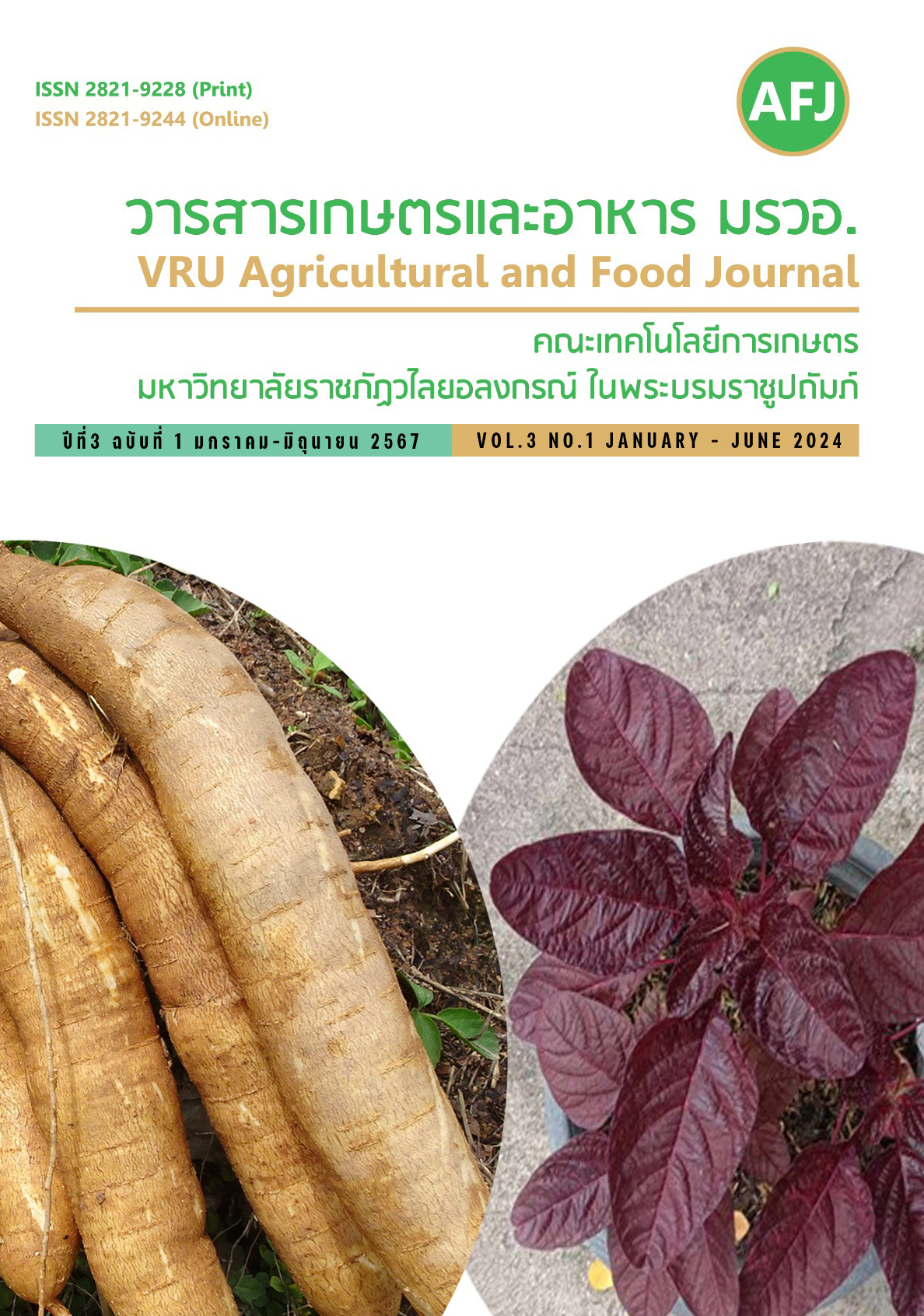Effects of Shading in Greenhouse and Non-shading in Natural Conditions on the Growth of Red Amaranth (Amaranthus tricolor L.)
Main Article Content
Abstract
The objective of this experiment was to compare the growth of red amaranth grown in a greenhouse with shading and grown under natural conditions without shading. Red amaranth seeds were grown in pots with planting material that was a fermented mixtures of soil, black rice husks cow manure, chicken manure, coconut husks and yellow rice husks with ratio 7:2:1:4:2:3. There were 2 treatments including 1) shading with 50% black salan in the greenhouse and 2) no shading under natural conditions The seeds were watered in the morning and evening for 4 weeks before harvesting. The results of the experiment found that red spinach grown in the treatment 2 under natural conditions without shading grew better than that of red spinach grown in method 1, with a more plant height. stem diameter, fresh weight, dry weight, and number of leaves, which were significantly greater than red amaranth grown with shading in treatment 1 (P<0.01), but shading did not affect leaf area and R G B color value of the leaves, which were not significantly different. Red spinach grown without shading had a stem height of 19.70 centimeters, a stem diameter of 5.78 centimeters, a fresh weight of 21.86 grams, a dry weight of 2.56 grams, and a number of leaves of 10.75. Its color value R G B were equal to 109.20, 65.00 and 71.65, respectively. The exterior characteristic of leaves and stems had a darker red color than red spinach grown in method 1.
Article Details

This work is licensed under a Creative Commons Attribution-NonCommercial-NoDerivatives 4.0 International License.
This article is published under a Creative Commons Attribution-NonCommercial-NoDerivatives 4.0 International License (CC BY-NC-ND 4.0), which allows others to share the article with proper attribution to the authors and prohibits commercial use or modification. For any other reuse or republication, permission from the journal and the authors is required.References
Areesrisom, P., Toakaenchan, N., Kawaree, R., Thonnalak, T. and Areesrisom, K. (2018). Effects of shading during cultivation on chlorophyll and 2- acetyl-1-pyrroline contents of Pandanus amaryllifolius Roxb. Leaves. Journal of Agriculture 34(3): 353-362.
Benjawan, L., Promdang, S., Sukkhaeng, S. and Doung-ngern, U. (2019). Growth characteristics, protein, fiber and chlorophyll contents of eight amaranth cultivars. Agricultural Science and Management Journal 2(3): 84-93.
Detpiratmongkol, S. (2018). Effects of shading on growth and yield of barbed grass (Centotheca lappacea (L.) Desv.). Khon Kaen Agriculture 46 (supplement1): 501-507.
Jahan, F., Bhuiyan, Md. N. H., Islam, Md. J., Ahmed, S., Hasan, Md. S., Bashera, M. A., Waliullah, Md., Chowdhury, A. N., Islam, Md. B., Saha, B. K., and Moulick, S. P. (2022). Amaranthus tricolor (red amaranth), an indigenous source of nutrients, minerals, amino acids, phytochemicals, and assessment of its antibacterial activity. Journal of Agriculture and Food Research, 10 (100419), 1-7.
Kaewthongrach, R. and Yingjajaval, S. (2009). Leaf photosynthetic potential of Amaranthus tricolor. Agricultural Science Journal 40(3): 401-410.
Khandaker, L., Ali, Md. B. and Oba, S. (2008). Total polyphenol and antioxidant activity of red amaranth (Amaranthus tricolor L.) as affected by different sunlight level. Journal of the Japanese Society for Horticultural Science 77(4): 395-401.
Sabri, S. M., Lob, S. and Ibrahim, N. F. (2020). Effect of photo-selective netting on growth development of green amaranth (Amaranthus viridis L.). Universiti Malaysia Terengganu Journal of Undergrauate Research 2(3 ):67-72.
Suthon, W. (2019). Effect of shading on growth, yield and curcumin content of Zingiber montanum [Koenig] Link ex Dietr. Srinakharinwirot University Journal of Science and Technology 11(22): 146-156.

